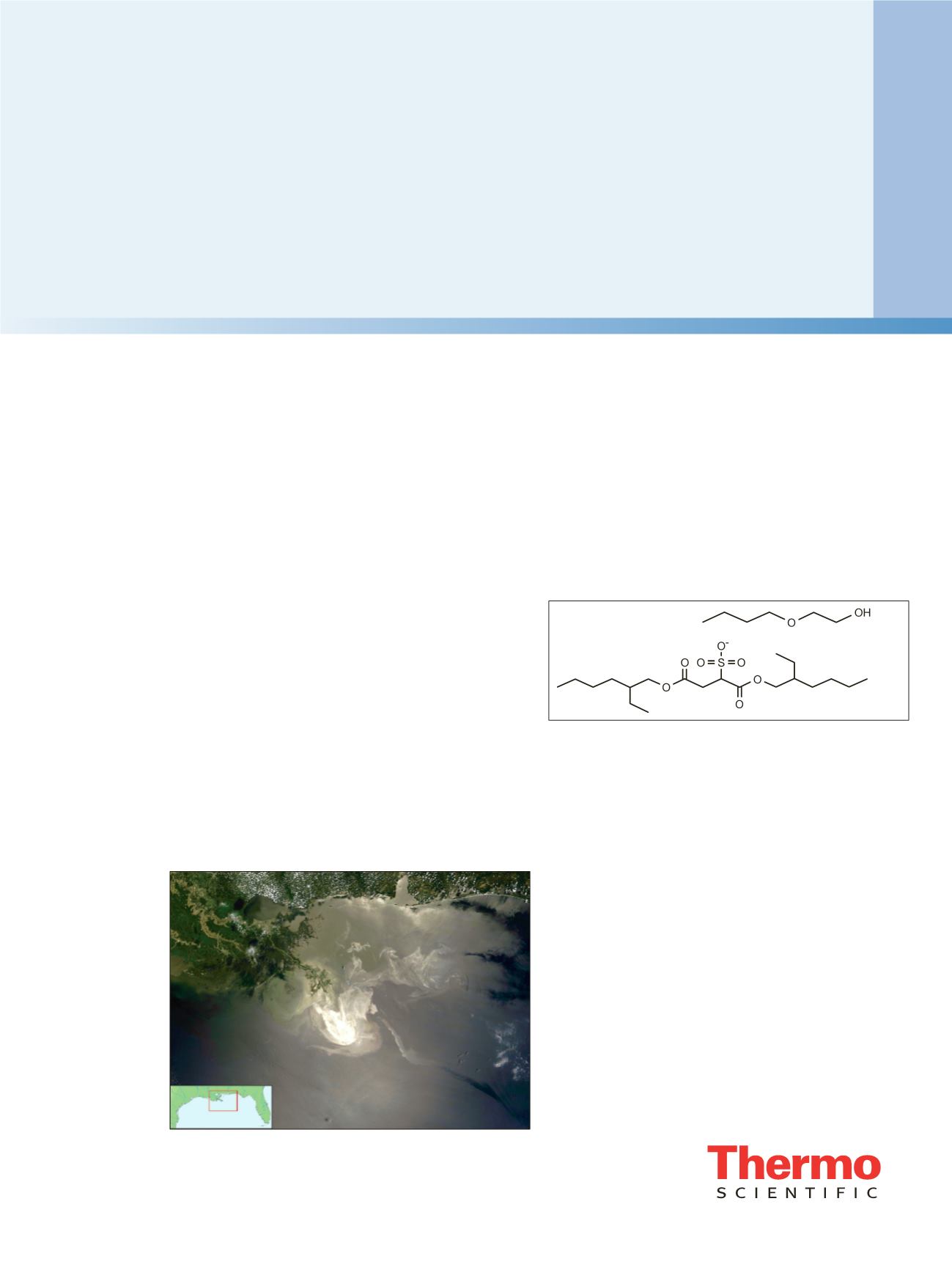

Simultaneous Determination of Oil
Dispersants in Seawater and Crude Oil by
LC and Tandem MS
Cesar E. Ramirez,
1,2
Sudha Rani Batchu,
1
and Piero R. Gardinali
1,2
1
Department of Chemistry and Biochemistry, Florida International University, Miami, FL
2
Southeast Environmental Research Center, Florida International University, Miami, FL
Application Note 586
Key Words
Environmental analysis, oil spill, Corexit
®
, Deepwater Horizon, Gulf of
Mexico, seawater
Goal
To develop a liquid chromatography with tandem mass spectrometry
(LC-MS/MS) method capable of simultaneously detecting and quantifying
DOSS and 2-butoxyethanol in a single chromatographic run without
preconcentration or cleanup steps. This method can serve as a tool to
track Corexit
®
after its usage in oil spills and determine if Corexit EC9527A
was employed.
Introduction
On April 20, 2010 the
Deepwater Horizon
(MC-252) oil
platform caught fire and sank in the Gulf of Mexico,
creating a large release of oil and gas from the riser pipe
and uncapped well head. Efforts to contain and clean up
the spill included heavy use of oil dispersants both above
and below the surface. The dispersants Corexit EC9500A
and Corexit EC9527A (formerly Corexit 9500 and
Corexit 9527, produced by Nalco, Naperville, IL) were
approved for use in the Gulf of Mexico oil spill by the
U.S. Environmental Protection Agency (EPA).
1
At least
1.8 million gallons of dispersants were applied during the
response and recovery process.
2
Corexit EC9500A was the
main product used in that effort.
Figure 1. Satellite view of oil slick in the Gulf of Mexico on May 24,
2010
According to available material safety data sheets, the
components of Corexit EC9500A are dioctyl
sulfosuccinate sodium salt (DOSS) (10–30% w/w),
hydrotreated light petroleum distillates (10–30% w/w),
and propylene glycol (1–5% w/w).
3
Corexit EC9527A
contains mainly 2-butoxyethanol (30–60% w/w) and
DOSS (10–30% w/w).
5
These mixtures of solvents and
surfactants reduce the interfacial tension between water
and oil, facilitating the breakup of the oil into tiny droplets
that are easily dispersed by wind and wave action.
4
The
structures of 2-butoxyethanol and DOSS are shown in
Figure 2.
Figure 2. 2-butoxyethanol and dioctyl sulfosuccinate (DOSS), the
main components of Corexit formulations
Although Corexit formulations have been found to have
only low-to-moderate toxicity to most aquatic species,
tracking these formulations in the environment is still a
priority because much of their fate is still not well
understood.
6
The large amounts of Corexit used in the
Gulf of Mexico gave rise to the need for an analytical
method capable of detecting its presence in seawater even
when large dilution factors are expected.
2-butoxyethanol is of interest because it is found only in
Corexit EC9527A. Despite the fact that a variety of other
sources can contribute to its presence in coastal areas,
chronic background environmental concentrations of
2-butoxyethanol are expected to be low because of its
high miscibility in water and its fast biodegradation
(half-life of 1–4 weeks) in environmental waters.
7
2-Butoxyethanol
Dioctyl sulfosuccinate
Image from NASA/GSFC, MODIS Rapid Response
and demis.nl



















